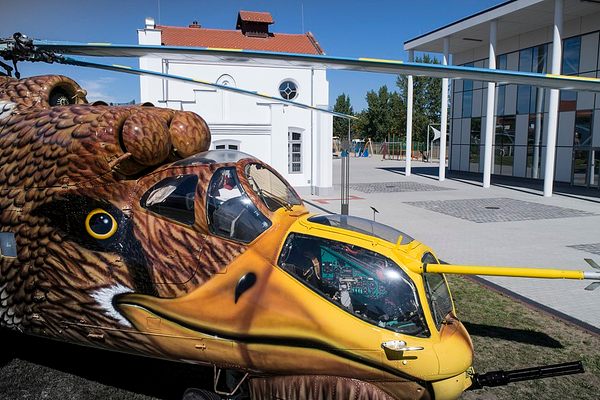Lyman Gilmore Middle School
A middle school sports field that many believe was the true location of the first successful powered flight - and not by the Wright Brothers.
It’s common knowledge that the Wright Brothers were the first to achieve powered and sustained heavier-than-air human flight…or were they?
While it is a generally accepted fact that Orville and WIlbur Wright were the groundbreaking leaders in powered flight, there is a small but tenacious percentage who feel the brothers were a fraud. The European aviation community was particularly skeptical, and the French flat out accused them of being charlatans. Out of all the counter claims and skepticism, perhaps the most interesting (and least confirmable) claim was made by a mysterious and secretive eccentric from Northern California named Lyman Gilmore.
Gilmore was an odd man. Generally bad tempered and poorly groomed, Gilmore was distinctly paranoid and secretive - traits that may have hindered his genius. Historian Kenneth Johnston wrote, “the extreme secrecy with which he (Lyman) cloaked his early activities has limited his fame and prevented any detailed verification.” The activities that the inventor and aviation pioneer kept so under wraps were lofty - designing an aircraft that would, ideally, allow earthbound humans to fly through the skies.
According to Gilmore (and his loyal fan base) he successfully attached a steam engine to a model aircraft May 15, 1902, more than a year before the first powered flight at Kitty Hawk. Despite his complete lack of evidence or eyewitnesses, his story was not completely disregarded, and the indications that do exist are, at the very least, intriguing.
Lyman Gilmore held two patents for steam engines, one submitted in 1902, a year before the flight was successfully accomplished at Kitty Hawk, suggesting he was at least on the right track, and had a jump on the brothers from the beginning. Gilmore’s two monoplanes and the hangar they were stored in were destroyed in a fire that the local media deemed accidental, but townsfolk whispered of arson, revenge for a neighbor’s pet dog that Gilmore was said to have shot. In even smaller circles, there are rumors of sabotage - a purposeful destruction of any evidence that the Wright Brothers wrongfully held their title. Whatever the cause, any documentation the hangar possessed, including the monoplanes, went up in smoke.
Later designs for gliders and advanced aircraft by the aviator lead to speculation; their advances and innovative features hinted as to where Gilmore would have been progression-wise in 1902, and the few engineers who actually saw the destroyed planes before the fire were of the opinion that the small monoplane could have successfully sustained flight with a highly experienced pilot. In later years, Gilmore claimed to have successfully flown the smaller plane, but there was no one to back his claims, as he refused to allow anyone to witness his experiments. The bigger plane was an eerie premonition of the first passenger planes, a large craft with closed cabin fuselage, a sign that the cantankerous, bearded inventor was way ahead of his time.
After the hangar fire and the loss of his aircraft, Lyman Gilmore took his eyes from the sky and focused on his mining interests and other, more grounded inventions, such as an early version of a rotary snowplow, and becoming more and more suspicious of authorities and investors alike, refusing to hand over his creations for any reasonable price with the fear he was being shamboozled. He died penniless in 1951, without family and wrapped in an overcoat he refused to take off for years that hospital staff promptly cut off his body and burned.
While the world may have forgotten, or likely never even heard of Lyman Gilmore, his Californian home town of Grass Valley keeps his name and legacy alive, both in local museums like the Narrow Gauge Railroad and Transportation Museum, and at the elementary school that now resides on his old airfield, proudly carrying his name. A mural on the outside wall of the auditorium portrays the man himself standing proudly at a drafting table against a blue-skied background reading “Flying into the Future”. A plaque on the school grounds says:
“GILMORE FLYING FIELD - THIS WINDSOCK MARKS THE SITE OF ONE OF THE FIRST FLYING FIELDS IN THE UNITED STATES. HERE, LYMAN GILMORE, A CONTEMPORARY OF THE WRIGHT BROTHERS PIONEERED IN AVIATION BY DESIGNING AND BUILDING HIS OWN PLANES AND GLIDERS AS EARLY AS 1898.”


















Follow us on Twitter to get the latest on the world's hidden wonders.
Like us on Facebook to get the latest on the world's hidden wonders.
Follow us on Twitter Like us on Facebook